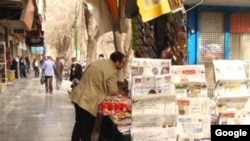Wednesday 29 January was a holiday in Iran. No newspaper was published in the capital Tehran or any other Iranian city on that day. There will also be no newspapers on Friday.
Thursday 30 January was what witty Iranians call a day between two holidays, and it just became a long weekend.
Only two newspapers, both affiliated with the holy shrine of Imam Reza in Mashhad, Qods and Khorassan, were published on Thursday and scantily distributed in Tehran and a few provincial capitals.
Most Iranian newspapers do not publish during New Year holidays, and the unusually long weekends during the holy months of Ramadan and Muharram which happen to coincide with major mourning ceremonies. And of course, there are the days between holidays which come as blessing for all those working for the government and do not need to go out to earn their daily bread.
During such periods, the state TV which has several dozens of channels with arguably modest quality, also joins the mourning ceremony. If it is the Iranian New Year holiday or any happy anniversary of anyone's birth, there are plenty of B-rated movies and run-off-the mill TV series and tasteless comedies often broadcast not for the first time, or second time. During these periods, news coverage is minimal, many news bulletins cease to exist, and others are cut down to a few minutes.
Iranian media complain about their shrinking popularity and warn that limitations on newsgathering, news writing and broadcasting are pushing increasingly larger number of Iranian audiences to watch, read and listen to Persian-speaking media based abroad.
Some official and academic reports in 2019 put the number of viewers of BBC Persian's flagship news bulletin at times of crisis up to 5 million, and Manoto TV's "Newsroom" program at twice as many. The estimate for the most important evening news bulletin on the state run IRIB1 is around one million.
The latest poll conducted by semi-official news agency ISNA's polling organization ISPA indicated that 60 percent of viewers in Tehran turned to foreign media in order to get reliable news about the November protests.
Meanwhile 71 percent of viewers who took part in the state-sponsored poll said they believe the news in Iranian media about the event is less reliable in terms of impartiality.
In spite of the limitations imposed by the government, the poll concluded that more than 90 percent of Iranians have access to foreign media for news and information. The government filters websites and jams radio and TV signals to hinder people's access to news and shuts down the Internet to curb the dissemination of news from Iran at times of crisis.
Last week, when President Hassan Rouhani in a speech looked down at his neighbors in Afghanistan, many Iranians and Afghans on social media reminded him that unlike Iran, people in Afghanistan have one state channel and several dozens of independent privately-owned TV channels, many independent newspapers and no journalist in jail, and if you do not win the elections you are not going to languish under house arrest for years.
They also teased Rouhani about the state of banking in Iran, telling him that Afghans have access to services such as Visa and Mastercard at their own local banks and can get cash in the currency of their choice, but that is beside the scope of this article.
A report read out at one of the latest meetings of the Iranian Journalists Trade Union in Tehran on January 14, shed light on limitations affecting freedom of speech in Iranian media with reference to the protests that shook the country in mid-November.
The report is based on content analysis of newspapers and major news agencies from November 15 when the unrest started until 10 days later. According to the report, IRGC-linked Fars news agency and the official agency IRNA, as well as Hamshahri, Iran, Kayhan and Donya-ye Eqtesad dailies published the largest number of reports about the events.
The report observed that most of the headlines of these reports were direct quotes, meaning that journalists have acted in a cautious way to protect themselves in cases of arrest or questioning by authorities.
Only 15 percent of the reports were published on the front-page while 65 percent were buried in other pages out of sight to attract less attention or invite less trouble.
According to the report, some 70 percent of the stories had no sourcing. The largest number of articles with a by-line were observed in conservative media which are closer to security forces and some of them are owned by them.
Most of the stories were brief news and factual reporting while there were only 27 reports based on observation in the field during ten days.
As far as topics and themes are concerned, 39 percent of the stories were about the rise in the price of gasoline, 14 percent about "riots" and "chaos", 13% about price control, 8% about "protests", 3% about arrests and nearly none about those who were killed by security forces.
Self-censorship by reporters and newspapers is absolutely justified by the possibility of harsh treatment in case of a clampdown on the press. Another reason is that newspapers and agencies are controlled by the government and security forces in many ways and sometimes owned or subsidized by them.
It would be pointless to look for independent reporting devoid of government influence in Iranian media. Limited signs of independence in reporting and opinions may be found on social media, where even meager traces of independent opinion and unbiased reporting is prone to attacks by thousands of state-sponsored trolls.






